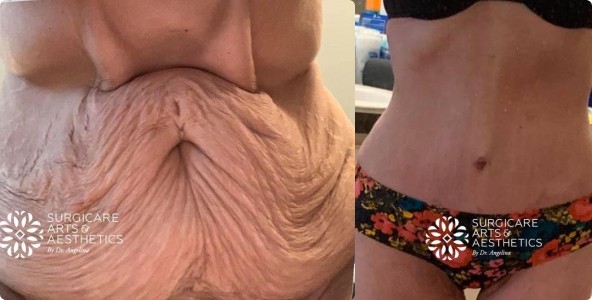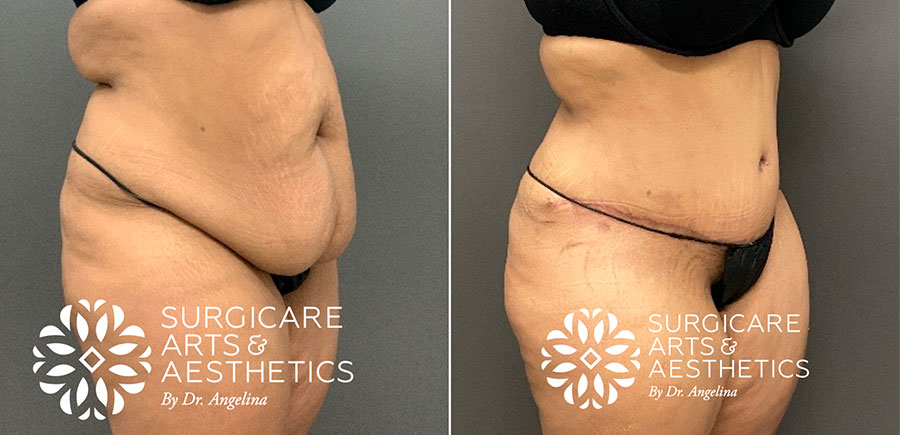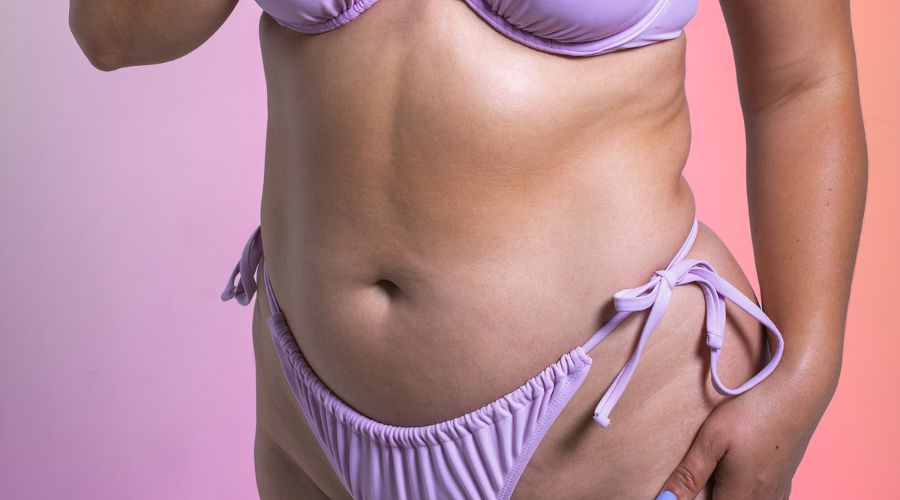Many people choose to undergo surgery to correct the accumulation of extra skin and fat that is left bulging or hanging from their abdominal area resulting from pregnancy or massive weight loss. This extra fat and skin can be embarrassing or impede the individual’s ability to move around freely or even wear certain types of clothing.
There are two surgeries that are often used in these circumstances: a tummy tuck or a panniculectomy. While both target the abdominal area and are used to create a flatter, more aesthetically pleasing midsection, the two surgeries are designed to address different issues.
Today we are going to look at and discuss these two different surgical procedures: panniculectomy vs. tummy tuck with photos, the specific issues they are designed to correct, how to know if you are a suitable candidate for these surgeries, and which one would work best for your circumstances.
What’s The Difference Between These Two Surgeries?
Both procedures work to make the abdomen flatter and more naturally contoured, but the areas of concern they target are significantly different, and they do not provide the same results. Let’s take a look at a quick overview of both procedures:
Panniculectomy
Many patients have panniculectomy surgery after they have lost a significant amount of weight through traditional means or undergoing bariatric surgery. A substantial loss of weight can leave behind a pannus or apron-like flap of extra skin that hangs from the lower abdomen. This apron of extra tissue can cause emotional anxiety, physical discomfort, and hygiene problems.
Many patients avoid social situations due to negative body image and embarrassment caused by these extra folds of skin. Patients can develop a rash, or fungal infections where the skin folds over on itself or rubs together, and this apron can be heavy, putting additional strain on their back as well as impeding their ability to move around comfortably.
A panniculectomy is performed while the individual is asleep to ensure their complete comfort. An incision is placed on the bottom part of the abdomen, where it would be covered up by a bikini. The length of the incision may run from hip to hip and will depend upon how much tissue needs to be removed. The hanging skin and fat are removed, and the surgeon smooths out the remainder and sutures it in place. Unlike a tummy tuck, this surgery does not include any muscle repairs or contouring through liposuction and concentrates more on improving function and not cosmetic appeal.
Scars are unavoidable after this type of surgery, however, your surgeon will do their best to position the incision as low as possible so it can be hidden by most clothing choices. How visible your resulting scar will be also depends on your skin type and how well you follow the aftercare instructions provided by your surgeon. The good news is that scars normally fade significantly over time.
Tummy Tuck
An abdominoplasty, or more often called a tummy tuck, is a surgery that corrects issues related to the upper and lower abdomen, unlike a panniculectomy, which concentrates only on the lower portion of the belly. Many patients undergo tummy tucks after having a baby to restore their midsection to the trim and toned condition it was in before becoming pregnant.
Postpartum patients and those who have experienced a tremendous loss of weight often also have damage to their abdominal muscles that causes this area to look flabby, droopy, and lax. The surgeon will normally tighten up these muscles during a tummy tuck, which helps with aesthetics but also offers functional purposes such as strengthening the pelvic floor and correcting urinary incontinence. Anyone who has ever suffered the embarrassment of sneeze-peeing will appreciate this correction.
During a tummy tuck, the surgeon may use a series of incisions to make the cosmetic corrections necessary to remove extra loose skin, make muscle repairs, and remove any unwanted fat with liposuction. The remainder of the skin and tissue will be pulled tighter and sutured, making the belly area much flatter and the midsection appear leaner and more contoured.
Tummy tuck incisions are normally made along the bikini line and can be different sizes depending on the amount of correction needed. In some cases, an upside-down T-shaped cut might be necessary if a significant amount of extra skin and tissue have to be excised from the bottom portion of the stomach. Tummy tuck scars can usually be hidden by a bathing suit or underwear, with the exception of any vertical incisions that may be necessary. If you take good care of yourself and your incisions after a tummy tuck, you should end up with thin scars that will fade significantly within a few years.
How Do You Know Which Procedure Is Right For You?
The best way to find out what procedure will correct your issues is to meet with a qualified cosmetic surgeon and have them take a look at your belly. The comparison table below may help you to get an initial idea of the type of surgery you might need.
| Panniculectomy | Tummy tuck | |
|---|---|---|
| Who Is A Candidate? | Patients who have a significant overhang of fat and extra tissue falling off the front of their belly under their navel. These patients may have medical or physical complications related to this extra skin and fat. | Patients who desire a more toned, flatter stomach, a trimmer waist, and to eliminate a muffin top, after losing weight, having a baby, or getting older. They may also need their muscles repaired to provide a smoother and stronger structure for their newly tightened skin. |
| What Does The Surgery Involve? | Gets rid of extra skin and folds of fat from the abdominal area under the navel. It does not fix stretched or ripped muscles and is classified as a reconstructive procedure.. | Eliminates excess skin (with a scalpel) and fat (using liposuction) from all around the midsection. Damaged abdominal muscles are repaired, helping to provide enhanced contour to the waist, hips, and belly. |
| What Does The Surgery Involve? | Gets rid of extra skin and folds of fat from the abdominal area under the navel. It does not fix stretched or ripped muscles and is classified as a reconstructive procedure.. | Eliminates excess skin (with a scalpel) and fat (using liposuction) from all around the midsection. Damaged abdominal muscles are repaired, helping to provide enhanced contour to the waist, hips, and belly. |
| Results To Expect | Enhanced mobility, greater ease in finding clothing that fits, and improvement in conditions such as infections or chafing. This surgery is geared more toward function than aesthetics. | Enhanced appearance of the abdominal area. Slimmer waist and hips, flatter belly, improvement in core strength, and some functional correction. This surgery is considered cosmetic. |
| How Long Is The Recovery? | 2-4 weeks to return to non-strenuous work, 6-8 weeks before any strenuous activities. | 2-3 weeks to return to non-strenuous work, 6-8 weeks to resume normal activities |
Where Can I Find Before And After Panniculectomy vs. Tummy Tuck Photos?
If you would like to see the results other patients have achieved, you can find more tummy tuck before and after pictures in the IBI Plastic Surgery & Med Spa gallery. To find before and after panniculectomy vs tummy tuck photos, check out this photo section of Realself.com.


Will My Medical Insurance Cover The Cost Of Panniculectomy Surgery vs. A Tummy Tuck?
Most medical insurance companies will provide coverage for a panniculectomy because it is not classified as cosmetic surgery. It is normally performed to correct a functional issue and not for aesthetic purposes. A tummy tuck is not covered by medical insurance plans because it is classified as an elective cosmetic surgery.
If you are struggling with negative body issues and are unhappy with the look of your midsection, talk with IBI Plastic Surgery & Med Spa. We would love to sit down with you and hear about your aesthetic dreams and goals. After learning more about you and obtaining more specifics about your circumstances, we will create a personalized plan to help you attain them. Set up a time to speak with Dr. Angelina Postoev, a triple board-certified cosmetic surgeon, in person or via telehealth, and find out if one of these procedures is the right choice for you.







